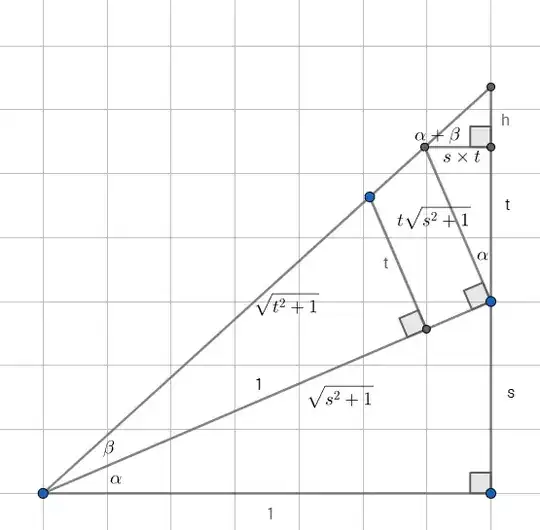To explain why $\arctan(u) + \arctan(v) = \arctan(\frac{u+v}{1-uv})$ only if $uv < 1$, we need to recognise the obvious restriction of $$-\frac{\pi}{2} < \arctan(u) + \arctan(v) < \frac{\pi}{2}.$$
We'll consider three cases: $uv = 1$, $uv > 1$ and finally $uv < 1$.
If $uv = 1$ (the trivial case), $u$ and $v$ must have the same sign and $v = \frac{1}{u}$. From the identity $\arctan(u) + \arctan(\frac{1}{u}) = \pm\frac{\pi}{2}$:
$$\arctan(u) + \arctan(v) =
\begin{cases}
\frac{\pi}{2}, & \text{if $u, v > 0$}, \\[2ex]
-\frac{\pi}{2}, & \text{if $u, v < 0$}. \\[2ex]
\end{cases}
$$
However, $\arctan(\frac{u+v}{1-uv})$ is obviously undefined when $uv=1$.
If $uv > 1$, both $u$ and $v$ must have the same sign again. Because of the behaviour of the inequality when dividing by a negative number, first consider the situation if $u, v > 0$:
$$uv > 1 \implies v > \frac{1}{u},$$
$$\arctan(u) + \arctan(\frac{1}{u}) = \frac{\pi}{2},$$
$$\therefore \arctan(u) + \arctan(v) > \frac{\pi}{2}.$$
Similarly, if $u, v < 0$,
$$uv > 1 \implies v < \frac{1}{u},$$
$$\arctan(u) + \arctan(\frac{1}{u}) = -\frac{\pi}{2},$$
$$\therefore \arctan(u) + \arctan(v) < -\frac{\pi}{2}.$$
Hence, we can see that whenever $uv > 1$, $\arctan(u) + \arctan(v) \notin (-\frac{\pi}{2}, \frac{\pi}{2})$.
If $uv < 1$, $u$ and $v$ may have different signs, but we can just consider $u > 0$, $u < 0$ and $u = 0$. If $u > 0$:
$$uv < 1 \implies v < \frac{1}{u},$$
$$\arctan(u) + \arctan(\frac{1}{u}) = \frac{\pi}{2},$$
$$\therefore \arctan(u) + \arctan(v) < \frac{\pi}{2}.$$
Similarly, if $u < 0$,
$$uv < 1 \implies v > \frac{1}{u},$$
$$\arctan(u) + \arctan(\frac{1}{u}) = -\frac{\pi}{2},$$
$$\therefore \arctan(u) + \arctan(v) > -\frac{\pi}{2}.$$
If $u = 0$, consider the original equation $\arctan(u) + \arctan(v) = \arctan(\frac{u+v}{1-uv})$:
$$
\begin{align}
LHS &= \arctan(0) + \arctan(v) \\
&= \arctan(v) \\
RHS &= \arctan(\frac{0+v}{1-0}) \\
&= \arctan(v) \\
&= LHS
\end{align}
$$
To summarise, we have shown that $$-\frac{\pi}{2} < \arctan(u) + \arctan(v) < \frac{\pi}{2}$$ is only true if $uv < 1$.
Bonus: To extend this to the arctangent subtraction formula,
$$\arctan(u) - \arctan(v) = \arctan(u) + \arctan(-v)$$
$$\therefore u(-v) < 1 \implies uv > -1.$$
